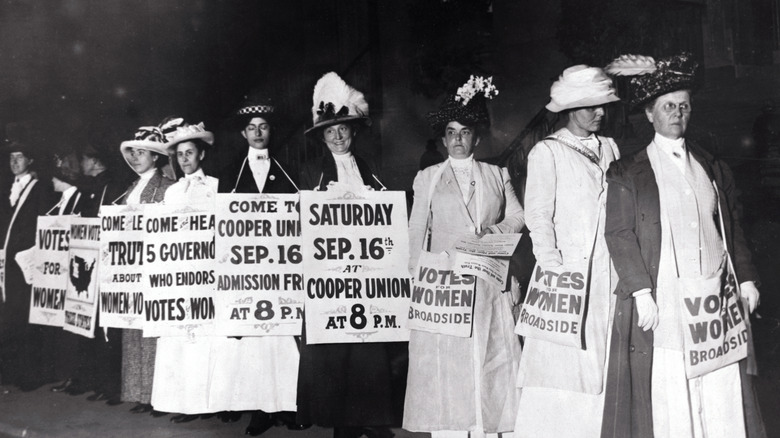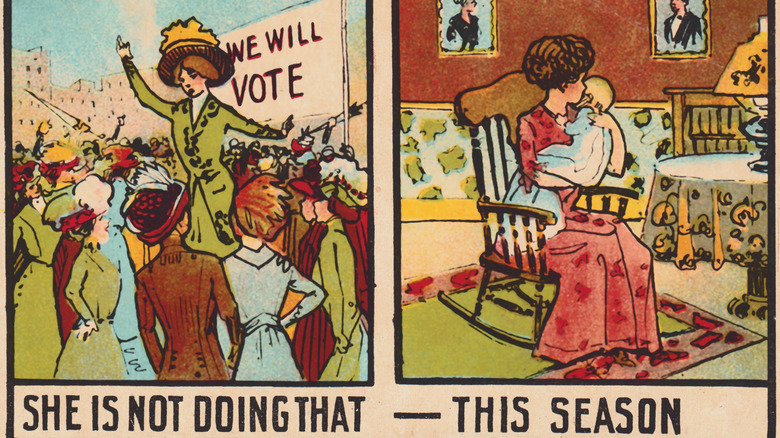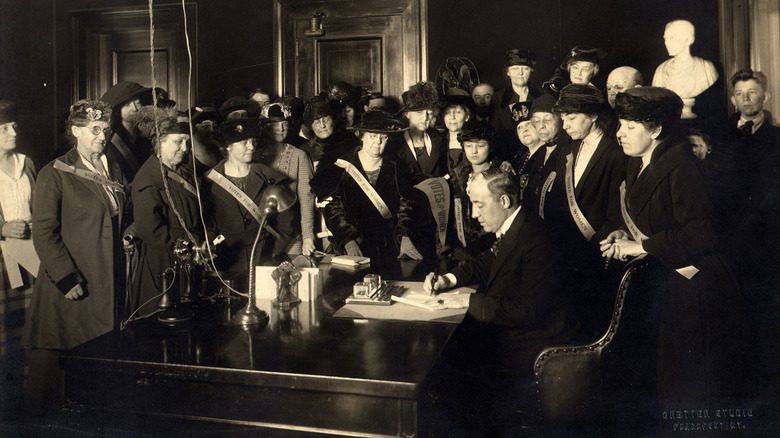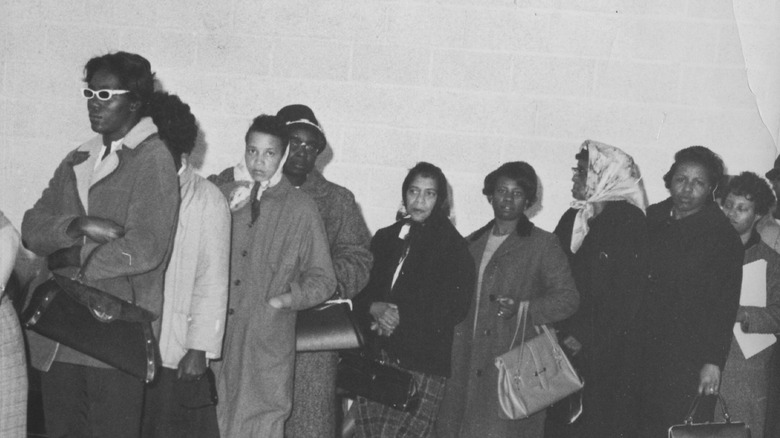Why Did It Take So Long For All Women To Be Able To Vote?
If you were alive when the 19th Amendment gave American women the right to vote in 1920, you learned pretty quickly that the hard-won change to the Constitution did not apply to women of color. Sure, Black women were involved in the suffrage movement along with white women. But when the vote was finally secured, racism was still right where it always was — pretty much everywhere. This is regardless of the fact that the 19th Amendment stated, "The right of citizens of the United States to vote shall not be denied or abridged by the United States or by any State on account of sex."
It wasn't just Black women who were discriminated against, either. Asian and Native American women were also not welcome at the polls because they were not granted citizenship until years after the 19th Amendment was ratified. Some Latin women also faced hurdles due to language barriers.
It wasn't until the Voting Rights Act passed in 1965 that women of any race who were U.S. citizens could cast their votes in elections without interference. After the 1776 founding of the United States, it took 189 years for all women who are U.S. citizens to have the right to vote. The reasons are multifold, having to do with long-held beliefs about the roles of gender and race in society.
Plenty of people opposed women's suffrage
The catalyst for the women's suffrage movement in the U.S. was the Seneca Falls Convention in 1848, when five women put an ad in local papers advertising a "convention to discuss the social, civil, and religious condition of woman," per Smithsonian. Ahead of the meeting, some of the women drafted the Declaration of Sentiments, which closely mirrored the Declaration of Independence. In the opening of the ladies' version, they added one simple word: "women." "We hold these truths to be self-evident; that all men and women are created equal," it read. There were 16 demands listed, and one of them was the right to vote.
Over the next several decades, suffragettes organized and formed state and national groups. People who opposed the movement did the same throughout the mid to late-19th century, and in 1911, a woman named Josephine Dodge established the National Association Opposed to Women's Suffrage. Those who were against women voting argued that they weren't smart enough to understand politics, were too busy with home management and child-rearing to have the time to engage in political matters, and flat-out didn't want the right or responsibility. Ongoing opposition from lawmakers and some members of the public was instrumental in keeping women from the ballot box for so long.
The 19th Amendment was largely a win for white women
While it's jarring to hear the way some people thought of women, it's important to remember that this perspective was all anyone knew. As the University College of London's professor of evolutionary anthropology, Ruth Mace, explained in The Conversation, male-dominated cultures were born out of the need to control material wealth as far back as when human societies became agriculture-based. Women became another aspect of life that men were considered masters over, and the idea of them having a voice in a world that had for the most part belonged to men for thousands of years was not something that was easy for people to accept — even some women.
All of that helps to explain why the idea of women voting was such a radical idea and why it took so long to come to fruition. Yet even when the 19th Amendment was finally ratified, it was largely a win for white women. On paper, any woman who was a U.S. citizen should have been allowed to vote, but in practice, local jurisdictions were the gatekeepers of who actually got to cast their ballots. And in 1920, Black people still lived under oppressive Jim Crow laws, especially in the South. With Black men securing the right to vote with the ratification of the 15th amendment in 1870, those who controlled the polls were already well-versed in how to dissuade minorities from voting, and they used the same tactics against women of color. Black women, however, didn't give up, and many stayed engaged in the hard work of securing civil liberties.
Old laws and scare tactics kept many women of color from the polls until 1965
Things like literacy tests and poll taxes played heavily in keeping women of color from easily exercising their rights to vote under the 19th Amendment. There were also grandfather clauses and good old-fashioned intimidation and violence. Asian women specifically were excluded until 1952 thanks to the Chinese Exclusion Act, which said Asian Immigrants couldn't be U.S. citizens. As for Latina women, they were required to pass English literacy tests in order to vote.
Finally, in 1965, the Voting Rights Act was signed into law. It was written to eliminate the ongoing discriminatory tactics — including poll taxes, i.e. paying a tax to vote — still being used to disenfranchise voters of minority groups, which meant that women of all stripes could vote. That said, not all women were there yet. Non-English speakers still had a difficult time at the polls, but in 1975, an extension to the Voting Rights Act was enacted, calling for voting materials to be made available "in the language of the applicable minority group as well as in the English language." In 2025, more than 100 years since the ratification of the 19th Amendment and 60 years after the Voting Rights Act passed, 67% of 16 million eligible Black women were registered to vote, per Higher Heights for America Pac.



